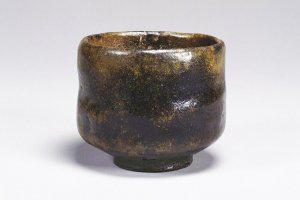In Kyoto there is a museum with a curious name - Raku Museum. For those who are interested in the history and culture of Japan, this name speaks volumes. Currently, 'Raku' is a common name for a type of ceramic technique that has a long history.
Raku bowls appeared at the end of the 16th century as a result of the collaboration of the famous tea ceremony master Sen-no Rikyu and the ceramics master Tanaka Chojiro. At the time, Chojiro was working with the sankai glazing technique using brown, green and cream-white colors which his father, who was originally from China, taught him. A lion figurine made in 1574 by Chojiro himself can be found in the museum and is its oldest exhibit.
As for Sen-no Rikyu, he devoted his life to tea, becoming tea master for both Oda Nobunaga and Toyotomi Hideyoshi. Regarding tea, Sen- no Rikyu said, "The meaning of tea is in the joy of feeling life at the moment. A flower enjoys life, even if it blooms for only one day. The main beauty is the radiance of blossoming life. Tea should be prepared with a calm soul. It is important to touch people's hearts in tea." Rikyu's tea house was simple – a latticed window, walls of rough clay, and a simple vase with a single flower.
For a long time, Rikyu worked with master Chojiro on the creation a hand-sculpted cup. The cup should have been rough and uneven, but very natural in the hand. Rikyu liked things that were simple and "didn't pretend to be anything else," as he said.

Their first items were not called ‘Raku’ yet. They were called 'ima-yaki' (modern product) then 'yuraku-yaki (yuraku product) and their workshop was located next to Jurakudai Palace, where Sen-no Rikyu.
After the death of Oda Nobunaga, his follower Toyotomi Hideyoshi invited Sen- no Rikyu and made him the chief master of the tea ceremony. Toyotomi built a new Jurakudai palace, so the products of the ceramic workshop were renamed 'juraku-yaki', abbreviated 'raku-yaki', literally - 'raku dishes'. It is believed that Toyotomi Hideyoshi gave Master Chojiro a seal with the hieroglyph 'raku'. Subsequently, Raku became the surname of the family that produced these products.

The modern Raku Museum is located next to the house and workshop of the Raku family. The museum was opened in 1978 and has a collection consisting of ceramics made by the heads of the Raku family and tea utensils passed down from generation to generation. The collection has been formed for more than 450 years as standards of craftsmanship and technology for future generations with exhibits changing four times a year according to the seasons.
Open from 10-430pm, the Raku Museum is closed Mondays.
































